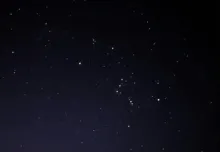
A Comet and a Meteor Shower in 2024
In 2024, a rare double celestial event will occur as the Orionid meteor shower coincides with the appearance of Comet C/2023 A3 (Tsuchinshan-ATLAS). The Orionids are expected to peak on October 21-22 and will be complemented by the comet's visibility in the night sky. Comet C/2023 A3 is anticipated to be sufficiently bright for naked-eye observation, enhancing the overall spectacle. Originating from Halley's Comet, the Orionid meteors, coupled with the comet's appearance, will offer a unique spectacle for stargazers, promising an even more remarkable night sky in late October 2024.
The Orionid meteor shower is one of the most anticipated celestial events of the year. Known for its fast, bright meteors and occasional fireballs, the Orionids offer a stunning display of nature’s cosmic fireworks. In 2024, this meteor shower will be particularly favorable for skywatchers due to dark skies from a waxing crescent moon, making it an excellent opportunity to witness the spectacle.
When to View the Orionid Meteor Shower in 2024
In 2024, the Orionid meteor shower will peak on the night of October 21 into the early morning of October 22. However, the shower runs annually from about October 2 to November 7, meaning that you might catch some meteors during this entire period. During its peak, you can expect to see 20 to 30 meteors per hour under ideal viewing conditions.
The best time to watch the Orionids is typically after midnight and before dawn, when the constellation Orion rises high in the sky. Around 2 a.m. local time is often considered the optimal viewing window, as Orion is positioned higher and the meteors seem to radiate more intensely from this point.
Tips for Viewing the Orionid Meteor Shower
To make the most of your viewing experience, follow these simple tips:
- Find a dark location: For the best visibility, seek out a location away from city lights. Rural areas, open fields, and elevated spots like hills or mountaintops provide optimal dark skies.
- Allow your eyes to adjust: It can take up to 30 minutes for your eyes to fully adjust to the darkness. Avoid looking at your phone or bright lights to maintain your night vision.
- Bring comfortable gear: Since the best viewing times are late at night, bring blankets, reclining chairs, or sleeping bags to stay comfortable and warm during the chilly autumn night.
- Be patient: Meteor showers can come in waves, so if you don't see anything immediately, don’t get discouraged. Give it at least an hour to experience the full beauty of the shower.
- Look to the constellation Orion: While the meteors will appear to radiate from the Orion constellation (near the bright star Betelgeuse), they can streak across any part of the sky. Orion rises in the east and will move across the southern sky throughout the night, so be prepared to scan a wide area.
History of the Orionid Meteor Shower
The Orionid meteor shower has been observed for centuries, with records of sightings dating back to 19th-century Chinese and Japanese astronomers. They are one of two annual meteor showers that originate from Halley’s Comet, the other being the Eta Aquarids in May.
Each year, Earth passes through the debris field left behind by Halley's Comet. As the comet’s particles enter Earth’s atmosphere, they burn up, creating the bright streaks of light known as meteors. Though Halley’s Comet only passes close to Earth once every 75 to 76 years, the meteors it leaves behind create a spectacular display nearly every October.
Origin of the Orionid Meteor Shower
The origin of the Orionid meteor shower lies in Comet 1P/Halley, more commonly known as Halley’s Comet. As Halley's Comet orbits the sun, it sheds particles of dust, rock, and ice. Over time, these particles are spread along the comet’s orbit, forming a trail of debris.
When Earth’s orbit intersects with this trail of debris, some of these particles are pulled into our atmosphere by gravity. These tiny fragments, most no larger than a grain of sand, travel at tremendous speeds of 66 kilometers per second (about 148,000 mph). When they enter the atmosphere, they heat up and vaporize, causing the streak of light we observe as a meteor.
The meteor shower gets its name from the constellation Orion, as the meteors appear to radiate from this region of the sky. Specifically, the point where the meteors seem to originate is near Orion’s brightest star, Betelgeuse, though the meteors can be seen in all parts of the sky.
The Orionid meteor shower is an annual highlight for stargazers. With its ties to the famous Halley’s Comet, its bright, fast-moving meteors, and the potential for breathtaking fireballs, the 2024 Orionid meteor shower promises to be a stunning celestial show. Mark your calendar for the peak on October 21-22, and prepare for a night of wonder under the stars.
